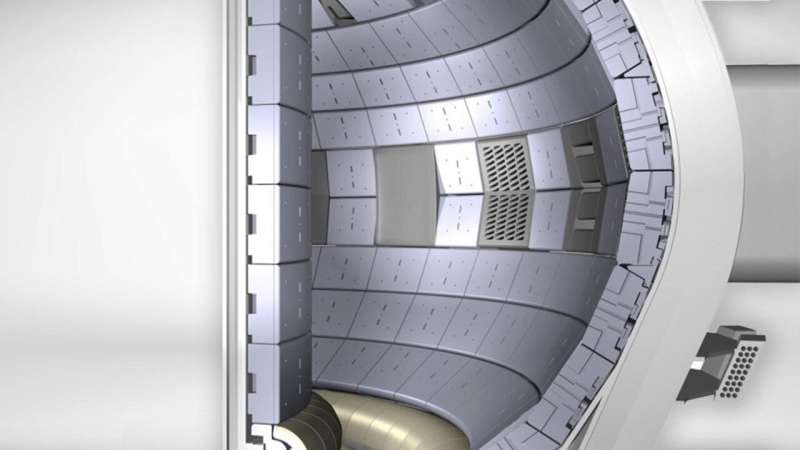
OCTOBER 7, 2024 by Rachel Kremen, Princeton Plasma Physics Laboratory
Collected at: https://phys.org/news/2024-10-wall-behavior-fusion-reactors.html
Fusion researchers are increasingly turning to the element tungsten when looking for an ideal material for components that will directly face the plasma inside fusion reactors known as tokamaks and stellarators. But under the intense heat of fusion plasma, tungsten atoms from the wall can sputter off and enter the plasma. Too much tungsten in the plasma would substantially cool it, which would make sustaining fusion reactions very challenging.
Now, researchers at the U.S. Department of Energy’s Princeton Plasma Physics Laboratory (PPPL) have experimental results suggesting that sprinkling boron powder into the tokamak could solve the problem. Boron partly shields the reactor wall from the plasma and prevents atoms from the wall from getting into the plasma.
A new computer modeling framework, also led by PPPL researchers, shows the powder may only need to be sprinkled from one location. The experimental results and computer modeling framework will be presented this week at the 66th Annual Meeting of the American Physical Society Division of Plasma Physics in Atlanta.
Joseph Snipes, deputy head for Tokamak Experimental Science, is optimistic about the solid boron injection system based on experiments that demonstrated reduced tungsten sputtering after a solid boron injection. The experiments were conducted in three tungsten-walled tokamaks worldwide: one in Germany, one in China, and one in the U.S.
“The boron is sprinkled into the tokamak plasma as a powder, like from a saltshaker, which is ionized at the plasma’s edge and then deposited on the tokamak’s inner walls and the exhaust region,” he said. “Once coated with a thin layer of boron, it will stop the tungsten from getting into the plasma and radiating away the plasma energy.”

Snipes and his colleagues are working on the boron injection system with the ultimate goal of potentially using it in the ITER Organization’s reactor-scale tokamak. The injection system is well suited to the task, as it can add boron while the machine is operating. It can also precisely control and limit the amount of boron injected. The deposited boron layers retain the radioactive element tritium, which must be minimized in the ITER tokamak to comply with nuclear safety. Scientists and engineers from ITER and the Oak Ridge National Laboratory also collaborated on this project.
Florian Effenberg, a staff research physicist at PPPL, led a separate project to create a computer modeling framework for the boron injection system in the DIII-D tokamak. The framework suggests that sprinkling the boron powder from just one location may provide a sufficiently uniform distribution of boron across the reactor components considered in the simulation domain.
“We’ve developed a new way to understand how injected boron material behaves in a fusion plasma and how it interacts with the walls of fusion reactors to keep them in good condition while they are operating,” said Effenberg.
The researchers’ approach combines three different computer models to create a new framework and workflow. “One model simulates the behavior of the plasma, another shows how the boron powder particles move and evaporate in the plasma, and the third examines how the boron particles interact with the tokamak walls, including how they stick, wear away and mix with other materials,” Effenberg said.
“These insights are crucial for optimizing boron injection strategies to achieve effective and uniform wall conditioning in ITER and other fusion reactors,” Effenberg said.
While the modeling framework looked at DIII-D, a tokamak operated by General Atomics in San Diego, the next phase of this research involves scaling the modeling framework to ITER. While DIII-D’s walls are made of carbon, ITER plans to have tungsten walls, so it will be important to research any differences in how the boron protects the walls.
More information: Abstract: meetings.aps.org/Meeting/DPP24/Session/UO06.10

Leave a Reply